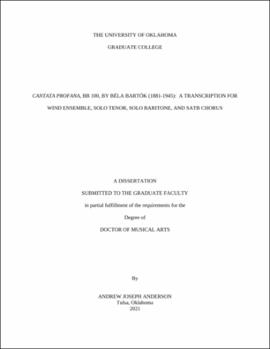| dc.contributor.advisor | Lamb, Marvin | |
| dc.contributor.author | Anderson, Andrew | |
| dc.date.accessioned | 2021-12-22T16:05:58Z | |
| dc.date.available | 2021-12-22T16:05:58Z | |
| dc.date.issued | 2021-12-17 | |
| dc.identifier.uri | https://hdl.handle.net/11244/332563 | |
| dc.description.abstract | Though the modern wind band includes in its repertoire works encompassing a wide range of composers and prescribed instrumentations, there is relatively little music written for wind band combined with SATB choir, and even less that is not patriotic of functionary in nature. Additionally, despite a repertoire populated abundantly by transcribed and original works from numerous Twentieth Century composers, works by the Hungarian composer Béla Bartók remain almost absent from the wind band’s frequently performed repertoire.
A transcription of Bartók’s Cantata Profana: The Nine Enchanted Stags (1930) for wind ensemble and choir will provide an example of both in a unique combination, in hopes of expanding what is a small base of works for those combined ensembles as well as providing the wind band a large-scale work of significance from the prominent Hungarian composer. The question of timbral density and its relation to instrumental/vocal balance is paramount throughout the transcription process; with no tutti string voice available, suitably transparent substituted instrumental combinations are needed during much of the piece. To this end, an orchestrational study of Bartók’s first two piano concerti provides insight, as movements in each are scored for winds and percussion, without strings, accompanying the piano soloist.
I argue further that the composer’s motivations behind writing the work are essential in order to understand how he musically frames the cantata as an assertion of Eastern European folk cultures in defiance of German hegemony. The theme of transformation that permeates the work is an encoded reinforcement of these folk cultures that creates a rebuke of German dominance, most obviously related to the metamorphosis of the hunter’s sons to stags described in the lyrics but also demonstrated by the arch form (A B A’) utilized throughout the work and by the use of modal scalar patterns that are associated with Eastern European folk music and altered through the course of the cantata.
The compositional intent of the cantata will be adhered to during the transcription, with the idea of transformation emphasized where applicable within the piece. The finished transcription will provide accomplished wind and choral ensembles a rare opportunity for collaboration while utilizing forces that need not approach the massive scale of the orchestral setting. | en_US |
| dc.rights | Attribution-NonCommercial-NoDerivatives 4.0 International | * |
| dc.rights.uri | https://creativecommons.org/licenses/by-nc-nd/4.0/ | * |
| dc.subject | Music | en_US |
| dc.subject | Transcription | en_US |
| dc.subject | Wind Ensemble | en_US |
| dc.subject | Choir | en_US |
| dc.subject | Bartok | en_US |
| dc.title | Cantata profana, BB 100, by Béla Bartók (1881-1945): a transcription for wind ensemble, solo tenor, solo baritone, and SATB chorus | en_US |
| dc.contributor.committeeMember | Sherinian, Zoe | |
| dc.contributor.committeeMember | Barker, Kash | |
| dc.contributor.committeeMember | Simon, Shanti | |
| dc.date.manuscript | 2021-12-02 | |
| dc.thesis.degree | D.M.A. | en_US |
| ou.group | Weitzenhoffer Family College of Fine Arts::School of Music | en_US |

